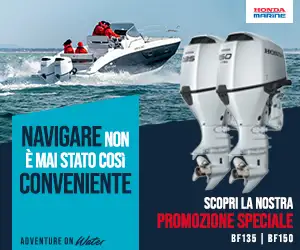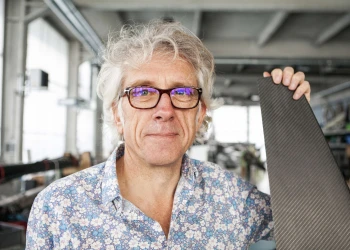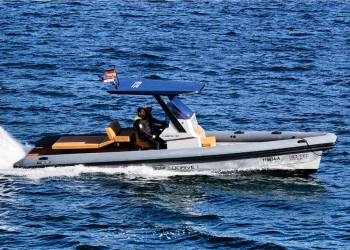
eD-TEC teams up with HSB university to develop performance vessel design and technology
eD-TEC teams up with HSB university to develop performance vessel design and technology
All great solutions start with a great idea – but developing that idea requires a number of steps to ensure success. The first, particularly when it’s a step away from the traditional and into the transformative, comes with the application of pioneering spirit and engineering excellence. For proof, look no further than eD-TEC, whose revolutionary all-electric eD-QDrive system is already proving itself in high performance mono- and multihull test boats.
The second steps comes with gathering the collective expertise of niche suppliers and technical partners to make sure that every component of the system – in eD-TEC’s case, the plug-and-play eD-QDrive units, the underlying eD-Technology Stack, the high-C-rate battery bank, and high-end component engineering throughout – is the pinnacle of design, performance and endurance. It is this wider Believer Team that has helped propel eD-TEC’s eD-QDrive platform toward commercial readiness.
The third step comes with the expansion of knowledge, and it is here that the Believer Team is welcoming Hochschule Bremen – City University of Applied Sciences (HSB) in Bremen, Germany, to its fold through a new and exciting collaboration that will have far-reaching impacts for performance vessel design.
Perfect partners
The partnership between eD-TEC and HSB is concentrated on the research and development of innovative solutions for hull, foil and propeller technologies. The aim is clear – to enhance both the efficiency and performance of existing and – critically – future vessels.
A central tenet of eD-TEC’s philosophy toward electrification of boats, based on the challenges created by hydrodynamic drag, is simple: “Go faster to go further,” as eD-TEC founder Michael Jost explains in typically efficient manner. “We have developed our system in tandem with the truth that unlike cars – where if you double your speed, you double your drag – if your boat has a stepped hull or foils, once you are planing or flying your drag actually drops considerably.”
The premise is simple – by developing an ultra-high-performance drive unit, based on surface-piercing propellers and powerful electric drive motors controlled by a hyper-intelligent AI Box control unit, and combining that with advanced hull forms and foiling technologies, the problems of hydrodynamic drag can be mitigated. The result is an all-electric, zero-emission boat platform that offers the thrill of performance and the practicality of extended range.
Objective lessons
To that end, the new collaboration with HSB covers five key objectives. First is the aim to enhance hull technology by finding solutions for existing and upcoming hulls by utilising current moulds and augmenting performance through foils or other technologies – essentially, finding new ways to mitigate that hull friction and in turn significantly increase the vessel’s range.
The second objective takes the first to its logical next step – using the design and engineering knowledge and experimental nature of HSB’s applied science department to explore from scratch the ultimate, optimised hull design. With an outside-the-box and blank-sheet ethos, this sort of research can lead to breakthroughs in hull design and in foiling systems that have the potential to maximise efficiency and performance – particularly pertinent to all-electric vessels.
Beyond the core aspects of naval architecture and appendage design, the collaboration also aims to focus on other aspects that are critical to the development of advanced e-propulsion systems and vessels. A core element of this is software, which plays an increasingly important role in modern e-vessel operation and efficiency. The HSB collab will take a deep dive into software research and development, focusing on the enhancement of system functionality as a whole and improving overall operational performance.
“The system developed by eD-TEC takes several massive steps forward in electric vessel propulsion, and it opens up an exciting new field of innovation and development in hull, foil and propeller design – elements to which the university is ideally suited to explore,” says Professor Bastian Gruschka, Dean of the Faculty of Nature and Technology at HSB. “The opportunity to rethink conventional approaches to hull design, to develop new foil technologies, to experiment with propeller design and to delve into software optimisation is core to what HSB does, and we look forward to seeing the fruits of our research and collaboration in helping to shape the next generation of super-efficient, high-performance and long-range electric vessels.”
In tandem with this comes the fourth objective, which centres on comprehensive research into propeller design specifically for the optimisation of performance in electrical systems. It will include the development of an ideal surface-piercing propeller designed to enhance efficacy.
The final objective draws on the wider appeal this research will hold – the collaboration has the prospect of securing funding from the German government, which could significantly bolster R&D efforts in advancing vessel technologies.
“Our new collaboration with HSB is hugely exciting both for what it means for the future of all-electric vessels and for what it says about eD-TEC’s eD-QDrive system and its potential to transform a sector of the marine industry,” enthuses Marc Jost, Chief Strategy Officer at eD-TEC. “It also stands as testament to the efforts and expertise of our extended Believer Team, who have been instrumental in the development of our groundbreaking technology and whose commitment is helping to shape the future of boating.”





